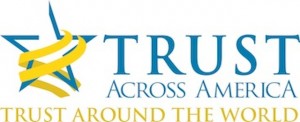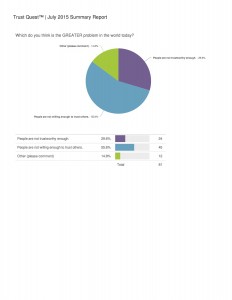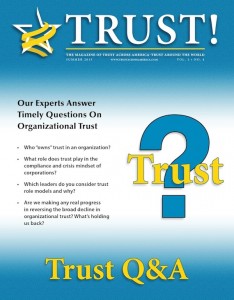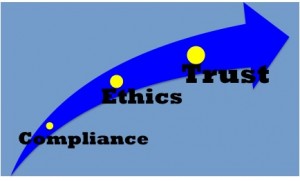I wish I could take credit for the title of this article but it belongs to Marillyn A. Hewson, Lockheed Martin’s CEO and a Trust Across America 2015 Top Thought Leader in Trust. In a recent article in National Defense Magazine, Ms. Hewson discusses the steps required to integrate trust and ethics. If you don’t have time to read the full article, these are the five steps:
- Establish an ethics program grounded in values
- Build a culture of communication
- Lead by example
- Address issues quickly
- Hold business partners to the same standards
As Hewson shows, this process pays off.
The leadership consulting firm KRW International recently looked into business ethics. They found that moral leaders actually tend to make their companies more profitable. Employees rated their bosses on attributes like character and integrity, and sure enough, businesses led by upright CEOs saw an average return on assets nearly five times greater than those led by bosses perceived to be less moral.
This is further evidence of Trust Across America’s updated business case for trust, the first article in the spring issue of TRUST! Magazine and our claim that trust is the “ultimate” compliance and ethics program.
The majority of business leaders continue to hold fast to their beliefs that trust is a “soft” skill, while the enlightened minority embraces trust as a business imperative and reaps the rewards.
Barbara Brooks Kimmel is the CEO & Co-founder of Trust Across America-Trust Around the World . Established in 2008, the program’s mission is simply to provide tools and assistance to organizations interested in building trust. Barbara runs the world’s largest organizational trust membership program. She is also the editor of the award winning TRUST INC. book series and the Executive Editor of TRUST! Magazine. In 2012 Barbara was named “One of 25 Women Changing the World” by Good Business International.
Barbara is an award-winning communications executive and former consultant to McKinsey who has run her own firm, Next Decade, Inc., that has been unraveling and simplifying complex subjects for over twenty years. She holds a BA in International Affairs from Lafayette College and an MBA from Baruch (City University of NY).






Recent Comments